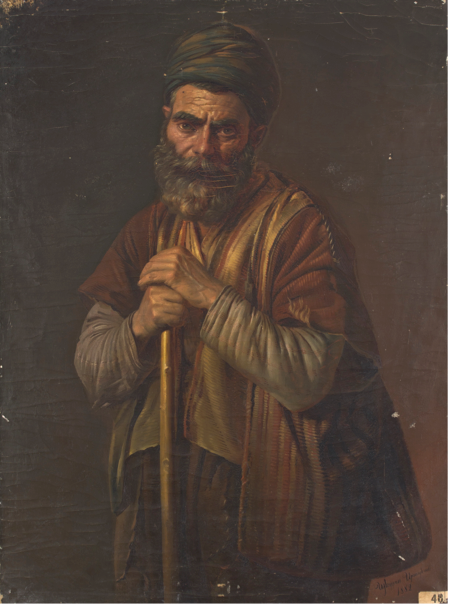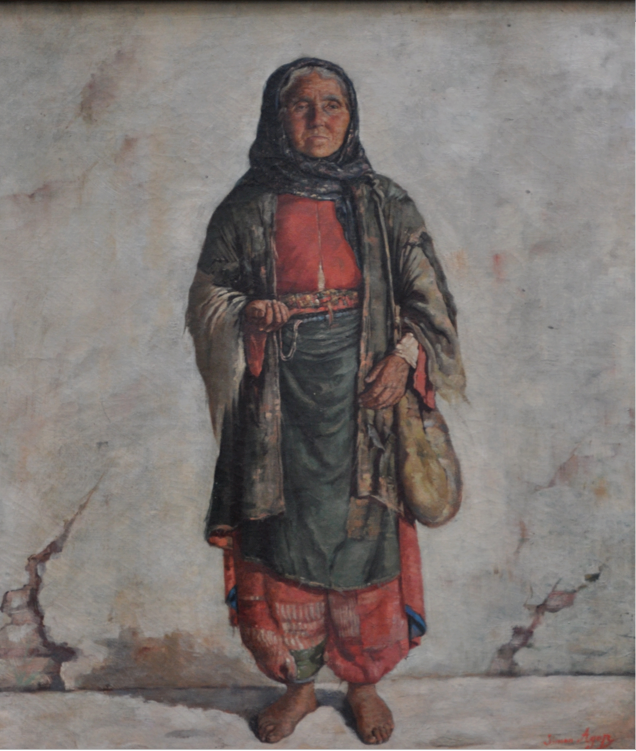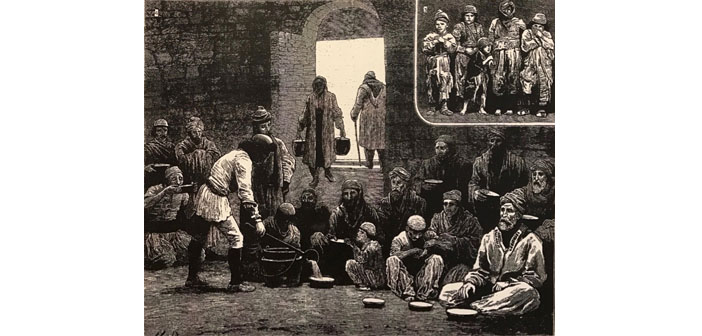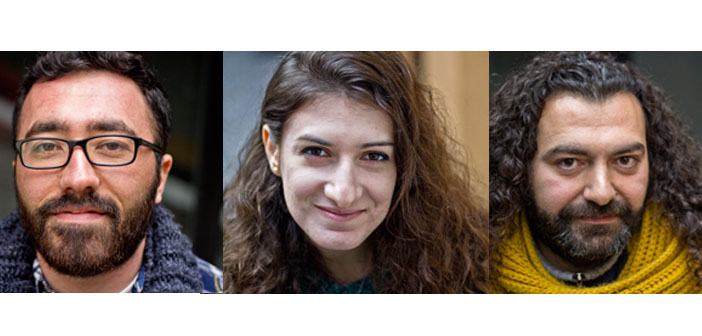Vazken Davidian made a presentation at “Van and the Region” conference organized by Hrant Dink Foundation and tried to provide an insight to the relationship between Ottoman Empire and Ottoman Armenians in a time of complicated ideological transformations. Here is a broad summary of the presentation by Davidian, who says that “The Figure of the Beggar from Van personified the economic wretchedness and misery of Ottoman Armenia on the streets and the hans [slums] of the imperial capital.”
‘The second [painting] represents an Armenian beggar from Van, with his colourful rags and dark blue headdress, who leaning upon his stick looks [at the viewer] with pitiful eyes. The expression of this painting is extremely tender and heart rending (յոյժ սրտառուչ). The sensitive brush of the author has succeeded in personifying the emigration (պանդխտութիւն) and plundering (հարստահարութիւն) of our provincial brethren. I saw foreigners who were saddened before this sight (երեւոյթ), and perhaps, wasn’t it natural that I should weep, I who is not a connoisseur of the arts (արուեստագէտ), but simply [and he signs off] AZKASER.’*
I would like to begin with the introduction of a brief excerpt from an article published on 28 May 1882 in the influential Constantinople Armenian newspaper Masis.
This short quote, which comprises the closing lines of the article Painting Exhibition (Նկարահանդէս), reprinted soon after, on 18 July 1882, in the newspaper Ardzagank [Echo] published in Tiflis in Russian Georgia, raises a number of issues that require elaboration and unpicking. Only some of these will be dwelled upon in this presentation.
The painting Armenian Beggar from Van to which the reviewer had responded to with such heightened emotion was the brushwork of the respected nineteenth century Constantinople artist Bedros Srabian (1833-1898), and is almost certainly the work currently listed as Poor Armenian Villager (Աղքատ Հայ Գիւղացի) in the collection of the National Gallery of Armenia in Yerevan. As described in the quote, Srabian’s painting represents a standing man dressed in pitiable rags, with his hands resting upon a stick, his pleading eyes gazing imploringly at the viewer. The fatalistic acceptance of a miserable predicament is reflected in the pathetic expression of his face. The dark background precludes any detraction from the man’s abject poverty or the artist’s direct incitement for pity and empathy for his subject.
This paper introduces Srabian’s Beggar, a painting that has recently also received the welcome consideration of the art historian Mary Roberts in her important 2015 book Istanbul Exchanges: Ottomans, Orientalists and Nineteenth Century Visual Culture, alongside prominent Constantinople artist Simon Hagopian’s (1857-1921) Beggar Woman from Van, executed in 1889, as important visual documents of urban artistic elites’ intellectual engagement with the socio-economic and political turmoil, and catastrophic famines, that characterise their perception of late nineteenth century Ottoman Armenia.
 Returning to the
opening quote, its author, the self-confessed ‘non-connoisseur
of the arts’, whose sole purpose had been the ascertainment of, and
I quote, ‘the position held by Armenian art’ at the
prestigious 1882 exhibition of the Artists of the
Bosphorus and Constantinople (the ABC club) under the patronage of
the British Ambassador Lord Dufferin, was none other than the
prominent Constantinople educator and
writer-turned-political-activist Minas Tcheraz (1852-1928). Unable to
delve into comprehensive details, I will, only suffice to point out
that Tcheraz’s adoption of the pseudonym, AZKASER [lover of nation,
Ազգասէր], is a significant clue that
represents social and political views held predominantly by liberal
elites from a vantage point of Constantinople at a specific
historical moment. Before moving on I would
also like to draw attention to Tcheraz’s close connection to
patriarchal circles: the reigning Patriarch of Constantinople, Nerses
Varjhabedian (1837-1884, Patriarch between 1874-1884), who had been
his former teacher at the Nubar-Shahnazarian School in Haskoy, and,
complicating matters further, the ex-Patriarch Mgrdich Khrimian
(1820-1907, Patriarch between 1869-1873, known affectionately as
Hayrig, little father), a native of Van and at that time the Primate
of Vaspouragan (the ancient Armenian name of the region that
correlates roughly to the area to the south and east of lake Van),
whom he had served as secretary and translator as member of the
Patriarchate’s delegation to the European Powers and the Congress
of Berlin in the aftermath of the Russo-Turkish War of 1877-1878.
Returning to the
opening quote, its author, the self-confessed ‘non-connoisseur
of the arts’, whose sole purpose had been the ascertainment of, and
I quote, ‘the position held by Armenian art’ at the
prestigious 1882 exhibition of the Artists of the
Bosphorus and Constantinople (the ABC club) under the patronage of
the British Ambassador Lord Dufferin, was none other than the
prominent Constantinople educator and
writer-turned-political-activist Minas Tcheraz (1852-1928). Unable to
delve into comprehensive details, I will, only suffice to point out
that Tcheraz’s adoption of the pseudonym, AZKASER [lover of nation,
Ազգասէր], is a significant clue that
represents social and political views held predominantly by liberal
elites from a vantage point of Constantinople at a specific
historical moment. Before moving on I would
also like to draw attention to Tcheraz’s close connection to
patriarchal circles: the reigning Patriarch of Constantinople, Nerses
Varjhabedian (1837-1884, Patriarch between 1874-1884), who had been
his former teacher at the Nubar-Shahnazarian School in Haskoy, and,
complicating matters further, the ex-Patriarch Mgrdich Khrimian
(1820-1907, Patriarch between 1869-1873, known affectionately as
Hayrig, little father), a native of Van and at that time the Primate
of Vaspouragan (the ancient Armenian name of the region that
correlates roughly to the area to the south and east of lake Van),
whom he had served as secretary and translator as member of the
Patriarchate’s delegation to the European Powers and the Congress
of Berlin in the aftermath of the Russo-Turkish War of 1877-1878.
The figure of the beggar, a commonplace sight on the streets of the Ottoman capital, had inevitably captured the attention of the nineteenth century artistic gaze, and several examples, by local as well as foreign artists visiting or living in Constantinople, survive. That the social phenomenon of begging was viewed as a major problem throughout the 1880s and 1890s can be attested by the presence of numerous reports and articles in the city’s multilingual press. Most of these make reference neither to Van nor Ottoman Armenians, but ought to be viewed either as engagements with the widespread occurrence of begging in the city or, more commonly, especially in the visual arts, renderings produced with an art buying public of a certain ethnographic sensibility in mind, where images of street types, especially exotic ones in timeless oriental settings, had become popular subjects for consumption. Consider, in passing, the following examples by two graduates of the city’s Imperial Fine Arts School, the already mentioned Simon Hagopian, and, the native of Trebizonde, Arshag Fetvadjian (1866-1947). With the art market central to their production, works such as these were not always favoured by the art buyers – there are, for example, recorded instances of visiting western artists being discouraged by their agents back home from sending paintings of beggars, being advised instead to concentrate on depictions of horses or camels.
Yet the presence of beggars in the city was also clearly perceived as an Ottoman Armenian problem. The Constantinople born artist and art historian Raphael Shishmanian (1885-1959) notes that in the 1870s desperate migrants [bantoukhds] from Ottoman Armenia, dressed in rags and in wretched conditions, unable to find work in the city, would wander the streets of Armenian populated districts begging, often attacked, abused or chased away by stone-throwers. He draws a direct link between the phenomena of bantkhdoutioun [պանդխտութիւն], meaning the emigration of thousands of mostly men from Ottoman Armenia, many from the villages of Van and Moush, who migrated to Constantinople in search of a livelihood, where they often worked as hamals [porters], and the figure of the beggar.
These threads are also woven into, and come together, in Srabian’s Armenian Beggar from Van, and Tcheraz’s emotional response to it. Furthermore, from a vantage point of urban Constantinople in 1882, the perceived characteristics of primarily rural Ottoman Armenia – economic stagnation, destitution, physical insecurity, misrule, plunder and social disorder – provide a stark context to the image and the text. At a time when the phenomenon of bantkhdoutioun was viewed to have reached catastrophic proportions, the bantoukhds personified the economic wretchedness and misery of Ottoman Armenia on the streets and the hans [slums] of the imperial capital. Their plight in the city had become a central preoccupation for many Constantinople Armenian intellectuals, especially those of a socially reformist mindset, whilst the widespread poverty in Ottoman Armenia was an ever-present feature on the pages of the city’s Armenian press. Consider for example Hrant’s [pseudonym of Melkon Gurdjian, 1859-1915] series of chronicles Letters of the Bantoukhd [Պանդուխտի Նամակներ], published in Masis between 1889 and 1892. In literature, and the visual arts, bantkhdoutioun was most prominently associated with the figure of the migrant hamal from Moush, with Moush acting as the popular metonymic signifier for an economically depressed and plundered Ottoman Armenia. Consider, for example, again in passing, Simon Hagopian’s especially poignant deeply psychological undated portrait of a bantoukhd hamal from Moush.
The situation in Ottoman Armenia – the wartime destruction, the dashing of expectations for reform at the Treaty of Berlin – provides a compelling background to paintings such as Hagopian’s Hamal and Srabian’s Beggar, and contemporary responses engendered. This is clearly seen in Tcheraz’s emotional text on Srabian’s painting: he was after all intimately familiar with the content of the petitions from Ottoman Armenia that flooded the Patriarchate throughout the 1870s into the 1880s, detailing misrule and plunder exacted by Kurdish tribes. Srabian’s reference to Van, meanwhile, further adds the post-war famine of 1879-1881 to the above, making it explicit in his conception and execution of the painting. The historian Özge Ertem has already considered this specific famine and the ensuing relief effort in her 2012 doctoral thesis Eating the Last Seed: Famine, Empire, Survival and Order in Ottoman Anatolia. Referred to in contemporary Armenian sources as the ‘Great Famine of Armenia’ or the ‘Famine of Van’, this man-made disaster had received extensive coverage by the Ottoman and international media. Consider, for example, again in passing, the following full-page visual representations of the famine on the front cover of the 22 May 1880 edition of the French journal Le Monde Illustré, depicting a group of starving people from Van or the full page series of illustrations, also showing ‘a group of starving peasants from Van’, published in the British journal The Graphic on 10 July 1880 captioned The Famine in Armenia: Sketches from Diarbekir.
A quick glance at the Ottoman Armenian press reveals the extensive, often daily, coverage of the famine and its relief as late as 1886. For example, on 15 March 1886 the influential Constantinople newspaper Arevelk [Orient] published all 56 articles of the lengthy 1885 Report of the Central Caretaker Committee for the Famine Stricken (Տեղեկագիր Սովելոց Խնամատար Կեդրոնական Յանցնաժողովոյ 1885) on its front page, summarising and listing the activities of the committee including its 233 meetings between 1880 and 1884, the types of aid (material and financial), and its accomplishments. Much emphasis was placed on the region of Van/Vasbouragan, where relief was overseen by Khrimian Hayrig himself. The complete Report, edited between 22 April and 9 September 1884, by Archbishop Maghakia Ormanian (1841-1918, Patriarch between 1896-1908), revealing the unprecedented scale of humanitarian efforts in Constantinople, and as far as America, India, Java and elsewhere, and including the names of all donors was published as a separate volume. Writing of the immediate aftermath of the War, and the catastrophic famine, in his three-volume magnum opus Azkabadoum (Ազգապատում, History of the Armenian Church), published in 1912, Ormanian, a leading actor in the relief effort, noted that the committee established to organise aid to Ottoman Armenia, had also ‘provided agricultural means, prepared agricultural planning, encouraged [the development of] various crafts, and facilitated the work of cultivators by providing them with animals and equipment on a loan basis, so as not to encourage handouts that had not resulted from toil to serve towards dangerous sluggishness (վտանգաւոր դատարկապորտութիւն) and lowly beggary (մուրացիկ ստորնութիւն)’. Ormanian particularly highlighted the establishment of a new agricultural school at Varak, as well as schools in locations such as Van and Aghpag. The post-famine organization and reform of the agricultural sector and engagement in the education of promising youths from all religious groups towards the development of Ottoman Armenia was widely praised.
Despite the increasingly tightening censorship of the Abdülhamid II (reign: 1876-1908/9) regime, news of the famine and relief efforts were widely presented to the reading public and provide a compelling backdrop to Srabian’s Beggar. Meanwhile, the duties of the Committee for Inspection and Controls (Encümen-i Teftiş ve Muayene), responsible for the approval of all publications also included the scrutiny of pictures. Mary Roberts rightly points out that the authorities, would not have viewed Srabian’s Beggar as a critique of the Ottoman state, but instead as a harmless ethnographic representation, thus permitting its uncensored exhibition. Yet it is conceivable that the censor, even if connecting the painting to the recent much-reported famine, might still not have considered it subversive. What remains certain is that Srabian’s Beggar had successfully bypassed any censorial constraints, and under a cloak of seemingly benign ethnographic naturalism, and through the use of allegory, had conveyed to the contemporary viewer Tcheraz, a troubling message on the complex situation in Ottoman Armenia, thus conjuring with the brush what the pen might not have been allowed to express. In her reading of Srabian’s Beggar, and the critic’s response, Roberts proffers a solely political interpretation, thereby ignoring the socio-economic environment, and especially the centrality of the famine in Ottoman Armenia in the conception or reception of the painting. Yet, the naming of Van clearly signifies the 1879-1881 famine looming large on Srabian’s and Tcheraz’s consciousness. To Tcheraz, the painting represented the personification of plunder and destitution, but also, crucially, in 1882, famine, a subtle allegory on the inability of Ottoman Armenia to feed itself.
Apart from Tcheraz’s response I have yet to unearth other contemporary Ottoman Armenian responses to Srabian’s Armenian Beggar in Van. Yet, on 28 June 1890, in a Letter published in the Tiflis newspaper Mshak, the godfather of Western Armenian Realism, the influential reformist writer and editor Arpiar Arpiarian (1851-1908), writing under the pseudonym Haygag [Հայկակ], lamented that a similar painting by Srabian of another bantoukhd, Manoug Aghpar, that he had much praised in 1884, had been dismissed by the public due to the perceived ‘ugliness’ of its subject’s face, resulting in the abandonment by Srabian of the bantoukhd as subject. This was unsurprising, noted Arpiarian bitterly, as ‘Constantinople Armenians lacked the sophistication of feeling and empathising with the beauty of the abject’.
 However, as late as
1889, artists were still engaging with the figure of the beggar from
Van. Simon Hagopian’s two surviving versions of the Beggar Woman
from Van suggest that not everyone viewed such images with disdain.
Whether these paintings were ever displayed in public, or reviewed, I
have yet to establish. In this version of the painting, Hagopian
utilises a gritty naturalism and powerful realist visual vocabulary
to elicit the empathetic response of the viewer towards the poor and
dispossessed rural population of Ottoman Armenia, two years after
another famine in 1887, and the bantoukhds on the streets of the
imperial capital. As in Srabian’s Beggar, nothing detracts from the
desperation and poverty of the old woman. Her bare feet and
outstretched hand, her fingernails inked with black dirt, evoke the
imploring fatalism of the posture and pathetic gaze of Srabian’s
male beggar. The beggar woman’s gender and old age add further
layers to her destitution, loneliness, defencelessness and cruel
abandonment in a patriarchal society. Hagopian’s background
especially recalls the practice of late nineteenth century
photographic studios of subjects being photographed outdoors, with
the blank canvas of the wall with its cracks serving to reinforce an
aura of hopelessness, heightening the realism of the scene.
However, as late as
1889, artists were still engaging with the figure of the beggar from
Van. Simon Hagopian’s two surviving versions of the Beggar Woman
from Van suggest that not everyone viewed such images with disdain.
Whether these paintings were ever displayed in public, or reviewed, I
have yet to establish. In this version of the painting, Hagopian
utilises a gritty naturalism and powerful realist visual vocabulary
to elicit the empathetic response of the viewer towards the poor and
dispossessed rural population of Ottoman Armenia, two years after
another famine in 1887, and the bantoukhds on the streets of the
imperial capital. As in Srabian’s Beggar, nothing detracts from the
desperation and poverty of the old woman. Her bare feet and
outstretched hand, her fingernails inked with black dirt, evoke the
imploring fatalism of the posture and pathetic gaze of Srabian’s
male beggar. The beggar woman’s gender and old age add further
layers to her destitution, loneliness, defencelessness and cruel
abandonment in a patriarchal society. Hagopian’s background
especially recalls the practice of late nineteenth century
photographic studios of subjects being photographed outdoors, with
the blank canvas of the wall with its cracks serving to reinforce an
aura of hopelessness, heightening the realism of the scene.
To conclude, Srabian’s Armenian Beggar from Van and Hagopian’s Beggar Woman from Van, painted in 1882 and 1889 respectively, were conceived during a decade of complex ideological transformations in the relationship of the Ottoman State and Ottoman Armenians. During the period that separates them much had changed: the situation in Ottoman Armenia had deteriorated significantly; culture had become increasingly politicised with the State perceiving or presenting any manifestation of Armenian identity as a threat; the already strict censorship regime had become tighter and even the mention of ‘Armenia’ suppressed. In 1889 it seems unthinkable for the censor to have allowed the publication of Tcheraz’s strongly worded response to Srabian’s Beggar. Meanwhile, the absence of the word ‘Armenian’ from the title of Hagopian’s painting, despite the obvious identity of the subject being apparent to all contemporaries, serves as further food for thought.
This paper has proposed that in these representations of beggars, the work of two important artists associated with the late nineteenth century urban liberal milieu of Constantinople, the naming of ‘Van’ was designed to draw attention to famine, most notably that of 1879-1881, alongside the widespread plunder and destitution in Ottoman Armenia. Just as the more common figure of the bantoukhd hamal from Moush, the beggar from Van personified Ottoman Armenia, imbuing the paintings with allegorical meaning and a powerful message that often successfully evaded the censor’s scalpel.
“A group of starving peasants from Van”
Referred to in contemporary Armenian sources as the ‘Great Famine of Armenia’ or the ‘Famine of Van’, this man-made disaster had received extensive coverage by the Ottoman and international media. Consider, for example, again in passing, the following full-page visual representations of the famine on the front cover of the 22 May 1880 edition of the French journal Le Monde Illustré, depicting a group of starving people from Van or the full page series of illustrations, also showing ‘a group of starving peasants from Van’, published in the British journal The Graphic on 10 July 1880 captioned The Famine in Armenia: Sketches from Diarbekir.
*Azasker: patriot





